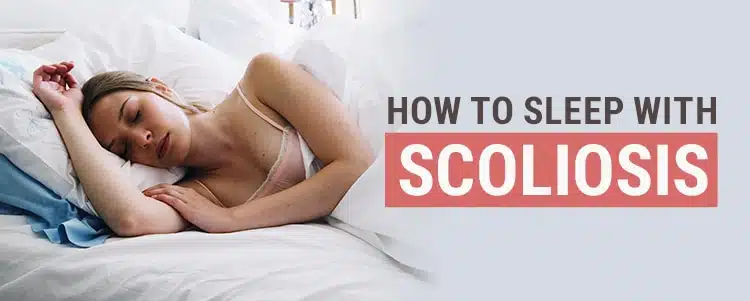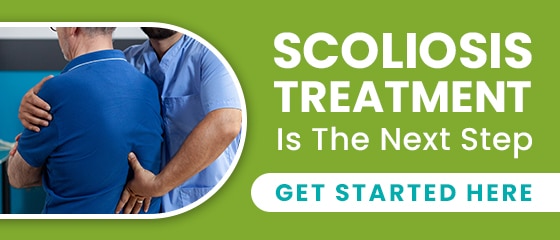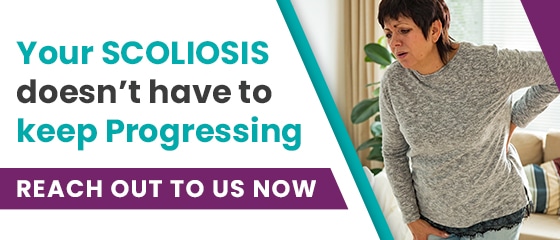A spinal deformity, such as scoliosis, can impact multiple areas of the body; on the flip side of that, there are many cases of scoliosis that go undetected for years as they have few noticeable symptoms. Just how much your sleep is affected by scoliosis, or how much discomfort you feel, will vary from person to person. For someone wondering how best to sleep with scoliosis, in terms of position, sleeping flat on the back is best.
As an incurable and progressive condition, if a person has scoliosis, they have to cultivate ways to live with it every day for the rest of their lives. Let’s talk about how sleep can be impacted by scoliosis and how best to limit that disruption.
Best Position for Sleeping with Scoliosis
Anyone who’s ever struggled with getting a good night’s sleep knows how important sleep is to daily life. Not only does sleep allow us to reset and start each day afresh, it also rejuvenates the mind and body.
If sleep is disrupted, it’s hard to feel good, and for someone with scoliosis, there are also the condition’s other effects to adapt to and live with.
The best way to sleep with any kind of spinal condition, in most cases, is flat on your back with some type of cervical pillow; cervical pillows are ideal for supporting the neck properly while you sleep. You’ll want to straighten your back as much as possible.
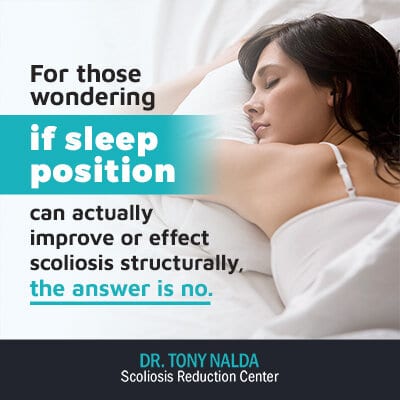
If you have scoliosis, there’s no specific side to sleep on to relieve symptoms. Sleeping on the right side is no better than sleeping on the left. For example, if you have a left lumbar curve, sleeping on your left side doesn’t help the condition, nor will it alleviate any scoliosis-related sleep problems.
For those wondering if sleep position can actually improve or affect scoliosis structurally, the answer is no. A person’s condition is impacted by its individual characteristics such as the type of curve, size or curve, location of curve, and their age, not how they sleep.
It’s important for people to understand, however, that regardless of sleep position, only proactive treatment can impact scoliosis on a structural level, but sleep can help make the body more responsive to treatment, and also help with pain management and mental health.
Sleeping on Your Side
When it comes to sleeping on your side with scoliosis, it’s about being comfortable, reducing pressure points, and maintaining optimal spinal alignment.
When it comes to which side is better to sleep on, the left or the right, there is a school of thought that suggests sleeping on the left side promotes better circulation as sleeping on the right side can restrict blood flow back to the heart; more definitive research results are needed on the topic.
When it comes to scoliosis pain, sleeping on the left or right side will be a personal preference, and when it comes to the challenge of sleeping with scoliosis, patients need to find a position that is as comfortable as possible to facilitate better sleep.
No side, left or right, can worsen or improve a scoliosis, so it really comes down to which side a person is most comfortable sleeping on.
Sleeping on the side is the next best sleeping position for people with and without scoliosis, after sleeping flat on the back, and adding a pillow between the knees can improve spinal alignment and ensure that the body’s weight is evenly distributed along the spine.
Sleeping on Your Back
Both for people with and without scoliosis, sleeping flat on the back is the optimal sleeping position.
Sleeping on the back means the body’s weight is evenly distributed along the spine, pressure points are minimized, and the spine is kept in a straight, natural, and neutral position.
Sleeping flat on the back means the spine is not exposed to any uneven pressure, no one section of the spine is experiencing adverse spinal tension, and if this position brings some pain relief for those experiencing scoliosis-related back pain, it can help with getting a good night’s sleep, which makes the body more able to deal with the rigors of treatment.
Adding a lumbar pillow to fill the gap between the lower back and the mattress can also keep the spine in a straighter and more-neutral position so there is a minimal amount of pressure on the spine during sleep.
For those whose scoliosis is in the upper back, sleeping on your back with a thin pillow under the shoulder blades can have the same effect: reducing pressure on the spine and keeping it in a straight and neutral position throughout the night.
Sleeping on Your Stomach
While many people enjoy stomach sleeping, this is the worst sleep position for spinal health.
Sleeping on the stomach places the spine in an unnatural position and increases pressure on the spine just through gravity alone.
Sleeping on the stomach also tends to put the head and neck at an unnatural angle, and as the curve of each spinal section is dependent upon the health of the others, if the neck is in an unnatural position, it can affect the spinal sections below.
The spine is not getting support when a person is lying flat on their stomach, and this doesn’t promote optimal spinal alignment.
Stomach sleeping forces the middle and lower sections of the spine to be unnaturally straight, and as we know the spine needs its natural curves and alignment to function properly, this is not a good sleeping position for people with, or without, scoliosis.
When the spine is put in a position that’s excessively straight, it’s not as strong, flexible, and can’t absorb/distribute stress effectively.
People with scoliosis have to be particularly mindful of sleep position because their spines, and surrounding muscles and nerves, are already exposed to uneven forces and adverse spinal tension, and placing added pressure on the spine can play into the condition’s asymmetrical effects and exacerbate symptoms.
In addition, while sleep is important for everyone in terms of both physical and mental health, for people with scoliosis, the spine and body needs to restore and rejuvenate, which helps create an internal environment that’s conducive to healing: making the spine more responsive to treatment.
Sleeping on the Floor
While people with scoliosis need a sleeping surface that is supportive, sleeping on the floor is not recommended.
There is no one mattress that’s ideal for people with scoliosis; preference will vary from one person to the next, but in general, factors like height, body type, weight, age, internal body temperature, chosen sleep position, and condition severity will all factor into whether or not a person with scoliosis finds a certain mattress comfortable.
People facing the challenge of trying to sleep with scoliosis and find a comfortable position need a good supportive mattress to sleep on.
While there is no shortage of mattress choices available, not all are created equal, and not all are equally supportive for people living with scoliosis.
While memory foam mattresses are seen by many as the most-comfortable mattress option, these don’t always provide as much support as a traditional mattress, and for people with scoliosis who need as much spinal support as possible, investing in a firm mattress and supportive pillows can make a big difference when it comes to the challenge of sleeping with a structural spinal condition.
Features to consider when considering the best mattress for scoliosis include firmness and flex, temperature regulation, and pressure points.
The ideal mattress for a person with scoliosis will provide enough firmness to adequately support the spine, will minimize pressure points by distributing the body’s weight evenly, and will help regulate body temperature during sleep.
Generally, it’s the hips and shoulders that become pressure points while sleeping, particularly for side sleepers, and these are two areas that experience a lot of postural deviation related to the condition’s uneven forces; when a good mattress helps to optimally distribute body weight, the pressure on those areas is minimized.
For someone wanting to produce a structural change while sleeping, the only way to achieve that is by wearing a corrective brace.
Corrective Bracing
Corrective bracing plays an important role in treating scoliosis. When it comes to the best way to sleep with scoliosis, in terms of actually addressing the structural issue of the condition itself, corrective bracing worn during sleep is the answer.
While traditional supportive bracing for scoliosis only ‘holds’ the spine in position by squeezing, corrective bracing actually corrects the spine by making it move against the bad curves, restoring as much of the good curves as possible.
Here at the Scoliosis Reduction Center®, our corrective ScoliBrace is customized to suit the body type and spinal curvature of each and every patient. Not only are they fully customized, our braces are constantly checked and adjusted to adapt to the growing bodies wearing them.
When it comes to reducing and stabilizing a scoliosis, corrective bracing is the best way to sleep with scoliosis.
For people who don’t have access to a corrective brace, the best sleeping position is on your back. The second-best sleeping position, if you don’t have a brace, is to sleep on your side. Whether that’s the left or right side doesn’t impact the scoliosis; it’s just a matter of which side is the most comfortable to you.
That being said, the very worst way to sleep would be on your stomach. Sleeping on your stomach can make your head and neck twist at unhealthy angles, and it can also cause your spine to arch, making your spine more out of alignment.
How can Scoliosis Affect Sleep?
While most people have heard of scoliosis and know it’s a type of spinal deformity, many don’t really learn about the condition until they, or someone they care about, has received a diagnosis.
As the spine plays a role in virtually all working systems within the body, a condition that throws off the biomechanics of the entire spine can impact the body in multiple ways.
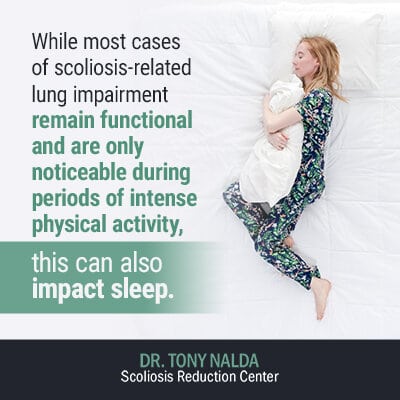
As I mentioned earlier, scoliosis can be very severe for some and milder for others. Most often, scoliosis in children and adolescents is a painless condition; in adults, it’s more common to cause the type of pain and discomfort that can affect sleep.
Scoliosis is also associated with lung impairment. While most cases of scoliosis-related lung impairment remain functional and are only noticeable during periods of intense physical activity, this can also impact sleep.
Particularly with thoracic curves (middle back), the ribs can be affected. As thoracic curves bend in the ribs, this often produces the characteristic rib hump. While this varies in severity, the spinal curvature impedes the ribs in their ability to move and impacts the mechanics of respiratory muscles, decreasing lung volume.
From years of listening to patients, I find that sleep can be affected by scoliosis in two ways, either in terms of discomfort, especially in adults, or in difficulty breathing with severe cases of lung impairment.
When it comes to alleviating sleep problems associated with pain or lung impairment, the best way to remedy this is to deal with the curvature structurally and reduce it with conservative and proactive treatment. As the spine’s healthy curves are restored, related complications such as discomfort and lung impairment will be lessened as well.
In addition to addressing the curvature structurally with active treatment, there are also some helpful tips for picking the best mattress and sleep aids for people with scoliosis.
Mattress and Sleep Aids
Everyone has a mattress/pillow preference. When it comes to sleeping with scoliosis, it’s all about doing what you need to get comfortable. If you’re not sleeping in a corrective brace, the best position is flat on your back.
One way to ease back pain for people with scoliosis is to use pillows to fill any gaps between the back and the mattress, allowing the spine to stay as straight and supported as possible; this is where cervical pillows can be helpful for neck support.
Although sleeping on the back is best, for side sleepers, placing a pillow between the knees can help keep the spine straight and avoid twisting motions.
When it comes to the best type of mattress for someone with scoliosis, think firm. While it can be tempting to get the squishiest softest mattress around, that does little when it comes to back support. Getting a firm mattress can help keep your spine well-supported and in a neutral position.
While no mattress or sleep aid can improve a scoliosis structurally, they can certainly help provide relief and support the spine.
Conclusion
For people with scoliosis, sleep is important as it helps better equip the body to deal with the challenges of the condition and treatment.
In terms of sleeping position, the best position for someone with scoliosis is to sleep flat on their back. The use of pillows to fill the gaps between the back and the mattress help to keep the spine in a straight and neutral position.
For those wanting to know what can be done to help reduce scoliosis during sleep, wearing a corrective brace is the answer. A custom corrective brace can help manipulate the spine to move in the ways we want it to, restoring the spine’s natural and healthy curves.
For people with severe scoliosis experiencing sleep problems due to lung impairment, sleep position, pillows, and a good firm mattress can only do so much. The only thing that really makes a difference is addressing the underlying structural issue of the scoliosis; this means treating the scoliosis and achieving a reduction so the rib deformity impacting the lungs is alleviated naturally.
No two experiences of living with scoliosis are the same. While many people live with the condition with no reports of sleep disruption, others can find it difficult to find a comfortable sleeping position.
If you have scoliosis and are experiencing sleep problems, don’t hesitate to discuss it with your doctor as any and all experienced symptoms should be addressed in your customized treatment plan moving forward.
